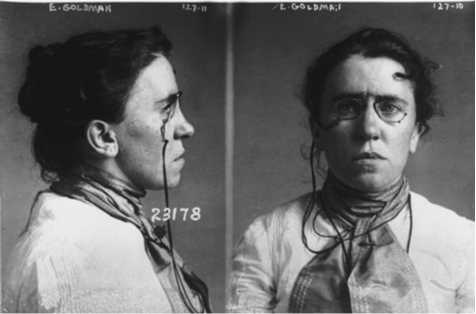In January 1886 a sixteen-year-old Jewish girl named Emma Goldman arrived in New York City from St. Petersburg, Russia, where her parents ran a grocery store. As soon as immigration officials had approved her entry into the United States, she hurried on to Rochester, New York, where her halfsister lived. Like most immigrants she expected the United States to be a kind of paradise on earth.
After moving in with her half-sister's family, Emma got a job in a factory sewing coats and earning $2.50 a week. She paid her sister $1.50 a week for room and board and spent sixty cents a week to get to her job. But when she asked her employer for more money he told her to "look for work elsewhere." She found a job at another factory that paid $4 a week.
In 1887 she married Jacob Kirshner, another Russian immigrant, but they soon divorced. In 1889 she took up with a group of radicals, most of them either socialists or anarchists. By this time Goldman was herself an ardent anarchist, convinced by her experiences that all governments repressed individual freedom and should be abolished.
In New York Emma fell in love with another Russian-born radical, Alexander Berkman. They started a kind of commune. Emma worked at home sewing shirts. Alexander found a job making cigars. They never married.
The couple moved to New Haven, where Emma started a cooperative dressmaking shop. Then they moved to Springfield, Massachusetts, where, with Berkman's cousin, an artist, they opened a photography studio. When this business failed, they opened an ice cream parlor.
Nearly all immigrants of that period retained their faith in the promise of American life even after they discovered that the streets were not paved with gold. But Emma was so disappointed that she became a radical.
In 1892 when she and Berkman learned of the bloody battle between Pinkertons and strikers during the Homestead steel strike, they closed the ice cream parlor and plotted to assassinate Henry Clay Frick, the archvillain of the Homestead drama. Berkman went to Pittsburgh, where, posing as a representative of an agency that provided strikebreakers, he got into Frick's office. Pulling a pistol, Berkman aimed for Frick's head but the shot went wide and hit Frick in the shoulder. Berkman then stabbed Frick, but still the Homestead boss survived. Convicted of the attempt on Frick's life, Berkman was imprisoned for fourteen years.
The next year Goldman was herself arrested and sentenced to a year in jail for making an "incendiary"speech urging unemployed workers to distrust politicians. Upon her release, Goldman went to Vienna, where she trained as a nurse. When she returned to America, she worked as a midwife among the New York poor, an experience that made her an outspoken advocate of birth control. She also helped organize a theatrical group, managed a touring group of Russian actors, and lectured on theatrical topics. In 1901,Goldman was arrested on charges of inspiring Leon Czolgosz to assassinate President McKinley. Czolgosz had attended one of

A "mug shot" of Emma Goldman, 1901. She was arrested so often that she took to carrying a book with her everywhere so that she would have something to read in jail if she were arrested.
Goldman's lectures, but there was no direct connection between the two, and the charges against her were dropped.
In 1906 Goldman founded Mother Earth, an anarchist jour-nal. When Alexander Berkman was released from prison later that year, she made him its editor. Mother Earth denounced governments, organized religion, and private property. By this time Goldman had become a celebrity."She was considered a monster, an exponent of free love and bombs," recalled Margaret Anderson, editor of a literary magazine.
Now Goldman campaigned for freedom of speech and lectured in support of birth control. In 1915,after Margaret Sanger was arrested for disseminating information on birth control, Goldman did the same in public speeches. She was arrested and spent two weeks in jail.
Goldman regarded the Great War—and especially American entry in it—as a calamity beyond measure. In 1917 Goldman and Berkman were convicted of conspiring to persuade men not to register for the draft. They served two years in federal prison. In 1919 they were deported to Russia. Two years later, disillusioned with the Bolsheviks, Goldman left the Soviet Union.
"Red Emma"Goldman was not a typical American, but she was in many ways a typical American immigrant. She learned English and quickly became familiar with American ways. She worked hard and developed valuable skills. Gradually she moved up the economic ladder. And while she was critical of the United States, she was a typical immigrant also in insisting that she was an American patriot."The kind of patriotism we represent,"she said during her trial in 1917,"is the kind of patriotism which loves America with open eyes."




 World History
World History









